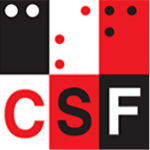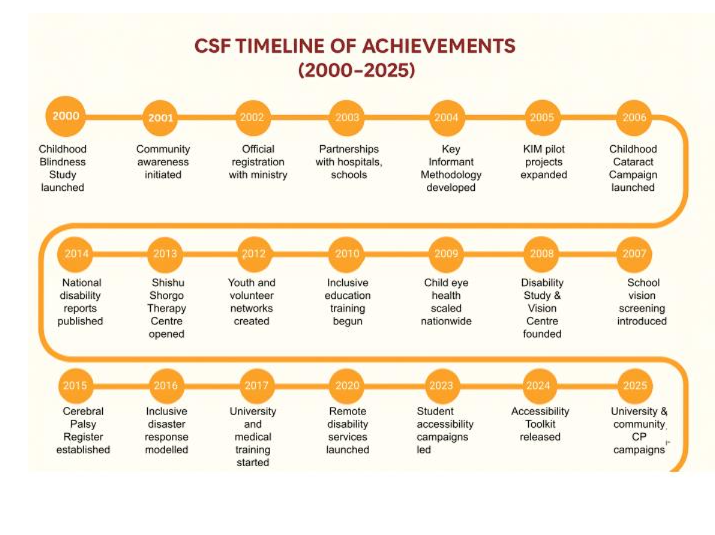At a glance…
In detail…
2000: Dr. Mohammad Muhit conducted a situation analysis, feasibility and pilot study on childhood blindness in Bangladesh on behalf of the International Centre for Eye Health in London under the guidance of Professor Clare Gilbert.
For the first time, a large national study on childhood blindness in Bangladesh was designed by Dr Muhit and Prof Gilbert, to identify the major causes of childhood blindness in Bangladesh. This project was known as ‘Childhood Blindness Project of Bangladesh (CBPB)’. Child Sight Foundation was evolved from CBPB.
2001: The National Childhood Blindness Study in Bangladesh commenced. For the first time in Bangladesh, a community based case detection and referral system for childhood cataract was established.
2002: The National Childhood Blindness Study collected data on 1,935 blind children in 64 districts of Bangladesh.
Through the referral and treatment system, 831 children with cataract blindness were detected from 64 districts. They were examined by the field research team and referred to four eye hospitals in Dhaka, Comilla and Sirajganj. 733 children, who were cataract blind, received surgery.
Child Sight Foundation (CSF) receives recognition from The Ministry of Social Welfare, Government of Bangladesh.
2003: First National Workshop on Childhood Blindness in Bangladesh was organized in Dhaka, with attendance from government ministries, NGOs, academic institutions and international participants. Research findings were presented and an action plan was drawn up.
The childhood blindness study found that there were 40 000 blind children in Bangladesh of which 12,000 children were suffering from blindness due to cataract.
The study found the Key Informant Method (KIM) to be the easiest way to identify blind children and to refer them to hospital for high quality treatment.
2004: CSF is registered by The NGO Affairs Bureau.
A pilot project commenced in 5 districts in the northern part of Bangladesh to identify blind children using the KIM. 1,500 blind children are identified and 400 are referred for free cataract surgery. The first national conference on childhood blindness in Bangladesh is held. The Child Sight Network (CSN) is formed by 30 NGOs.
2005: First pilot phase on case findings is successfully completed in 5 districts and 40 sub districts identifying 3 000 blind children and referring 800 children to hospital for cataract surgery.
2006: Bangladesh Childhood Cataract Campaign (BCCC) began in 14 districts and 103 sub-districts in Dhaka Division to identify blind children and refer them for cataract surgery. A health communication project, including posters, television segments, the radio, magazines and documentaries commenced to raise community awareness of childhood cataract.
2007: Successful completion of blind children identification from Dhaka division.
Child Sight Journalist Fellowship, Sight Fair and Sight Journey media campaign for ‘World Sight Day’ was organised.
2008: The first national survey on childhood disability in Bangladesh commenced with support of CSN partners. It is expected that this study will reveal the best method to identify children with disabilities.
CSF established paediatric eye hospital in Dhaka with modern eye equipment, which has provided free cataract surgery for 1,500 children over the last three years.
2009: CSF organized the first international volunteer camp in Bangladesh. Three internationals and one volunteer attended the camp to share their skills with CSF staff. This was very useful as it increased both side’s knowledge of rehabilitation and inclusive education of children with disabilities.
2010: CSF conducted research project on Rapid Assessment of Avoidable Blindness. Around 11,000 adults were examined by the ophthalmologist in five districts (Narail, Jamalpur, Gazaipur, Kishorganj and Cox’s Bazar).
2011: In addition to the ongoing projects, CSF launched several new projects in 2011. These included: Mainstreaming children with disability, supported by Light for the World, the Netherlands
Cerebral Palsy parent training program in collaboration with the International Centre for Eye Health, London
CSF-Fred Hollows Foundation Journalism fellowship funded by The Fred Hollows Foundation
Research on Rapid Assessment of Avoidable Blindness in 3 districts (Tangail, Natore and Kustia) funded by The Fred Hollows Foundation
Development of Manual on Detection and Management of Childhood Cataract in Asian Countries with financial support from Light for the World, The Netherlands
Developing Human Resource to Utilise Paediatric Eye Care Services in Bangladesh, supported by USAID.
2012: CSF has completed study on childhood disability in BangladeshOrganised international training course on Key Informant Method to detect visual impairment children among participants from Asian countries (Afghanistan, China, India, Indonesia and Thailand)
Book launched on Cataract in Children in Asia: Detection, Management and Programme planning for eye care professionals.
2013 — CSF intensified policy advocacy, producing briefings and recommendations aimed at improving accessibility in public education and services.
2014 — The organisation embraced digital communication, creating a basic website and social-media presence to reach younger audiences and donors.
2015 — CSF opened pilot regional hubs to strengthen local delivery and to train more disability-aware volunteers in rural and urban areas.
2016 — Disaster-preparedness and inclusive response became part of programming, ensuring people with disabilities were included in emergency planning.
2017 — Partnerships with university researchers and student groups grew, enabling evidence-based projects and volunteer placements.
2018 — CSF published its first set of digital resources and short online training units for teachers, caregivers, and community leaders.
2019 — The organisation mobilised large volunteer drives and community events, raising profile and collecting lived-experience stories to inform future advocacy.
2020 — In response to the COVID-19 pandemic CSF shifted many services online, prioritised remote support, information sharing and ensuring vulnerable people could access essential services.
2021 — CSF ran hybrid support programmes (online + safe in-person) and public information campaigns to improve access to health and social services during the pandemic recovery phase.
2022 — In-person outreach resumed at scale; CSF restarted community booths, workshops, and coordination with local institutions to address accessibility gaps revealed during the pandemic.
2023 — CSF scaled up advocacy and petitioning work calling for improved accessibility in educational institutions, combining campus events with online petition tools to gather broad support.
2024 — The organisation consolidated lessons from recent years, refined volunteer training, and developed a toolkit for student groups and campus campaigns on accessibility and inclusion.
2025 — CSF carried out high-visibility university and community campaigns (including campus petition drives and multi-booth awareness events), mobilised student volunteers, and amplified outreach through focused social-media boosts and local media coverage.

